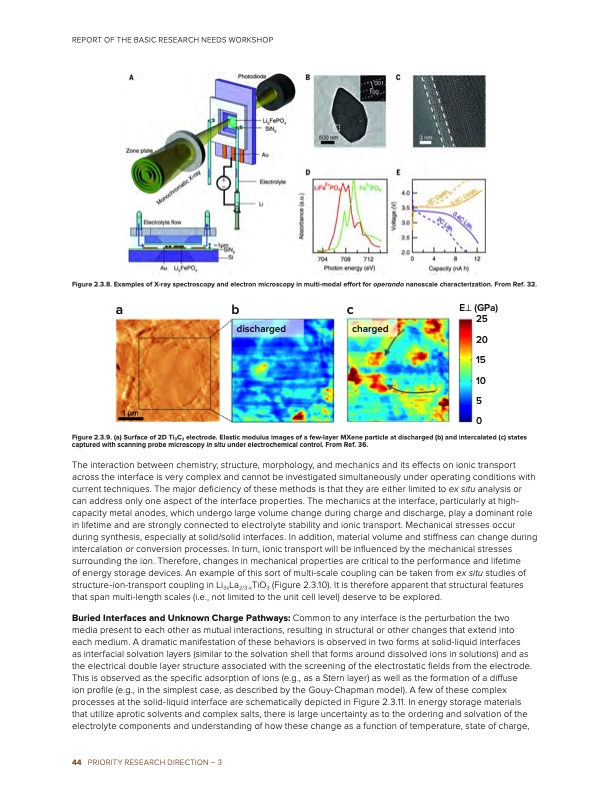
PDF Publication Title:
Text from PDF Page: 050
REPORT OF THE BASIC RESEARCH NEEDS WORKSHOP Figure 2.3.8. Examples of X-ray spectroscopy and electron microscopy in multi-modal effort for operando nanoscale characterization. From Ref. 32. abc E⊥ (GPa) 25 20 15 10 5 0 1 μm discharged charged Figure 2.3.9. (a) Surface of 2D Ti3C2 electrode. Elastic modulus images of a few-layer MXene particle at discharged (b) and intercalated (c) states captured with scanning probe microscopy in situ under electrochemical control. From Ref. 36. The interaction between chemistry, structure, morphology, and mechanics and its effects on ionic transport across the interface is very complex and cannot be investigated simultaneously under operating conditions with current techniques. The major deficiency of these methods is that they are either limited to ex situ analysis or can address only one aspect of the interface properties. The mechanics at the interface, particularly at high- capacity metal anodes, which undergo large volume change during charge and discharge, play a dominant role in lifetime and are strongly connected to electrolyte stability and ionic transport. Mechanical stresses occur during synthesis, especially at solid/solid interfaces. In addition, material volume and stiffness can change during intercalation or conversion processes. In turn, ionic transport will be influenced by the mechanical stresses surrounding the ion. Therefore, changes in mechanical properties are critical to the performance and lifetime of energy storage devices. An example of this sort of multi-scale coupling can be taken from ex situ studies of structure-ion-transport coupling in Li3xLa2/3-xTiO3 (Figure 2.3.10). It is therefore apparent that structural features that span multi-length scales (i.e., not limited to the unit cell level) deserve to be explored. Buried Interfaces and Unknown Charge Pathways: Common to any interface is the perturbation the two media present to each other as mutual interactions, resulting in structural or other changes that extend into each medium. A dramatic manifestation of these behaviors is observed in two forms at solid-liquid interfaces as interfacial solvation layers (similar to the solvation shell that forms around dissolved ions in solutions) and as the electrical double layer structure associated with the screening of the electrostatic fields from the electrode. This is observed as the specific adsorption of ions (e.g., as a Stern layer) as well as the formation of a diffuse ion profile (e.g., in the simplest case, as described by the Gouy-Chapman model). A few of these complex processes at the solid-liquid interface are schematically depicted in Figure 2.3.11. In energy storage materials that utilize aprotic solvents and complex salts, there is large uncertainty as to the ordering and solvation of the electrolyte components and understanding of how these change as a function of temperature, state of charge, 44 PRIORITY RESEARCH DIRECTION – 3PDF Image | Next Generation Electrical Energy Storage

PDF Search Title:
Next Generation Electrical Energy StorageOriginal File Name Searched:
BRN-NGEES_rpt-low-res.pdfDIY PDF Search: Google It | Yahoo | Bing
Sulfur Deposition on Carbon Nanofibers using Supercritical CO2 Sulfur Deposition on Carbon Nanofibers using Supercritical CO2. Gamma sulfur also known as mother of pearl sulfur and nacreous sulfur... More Info
CO2 Organic Rankine Cycle Experimenter Platform The supercritical CO2 phase change system is both a heat pump and organic rankine cycle which can be used for those purposes and as a supercritical extractor for advanced subcritical and supercritical extraction technology. Uses include producing nanoparticles, precious metal CO2 extraction, lithium battery recycling, and other applications... More Info
| CONTACT TEL: 608-238-6001 Email: greg@infinityturbine.com | RSS | AMP |